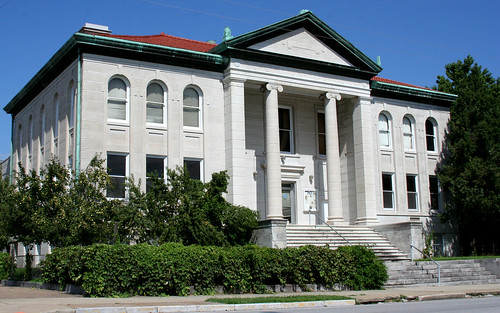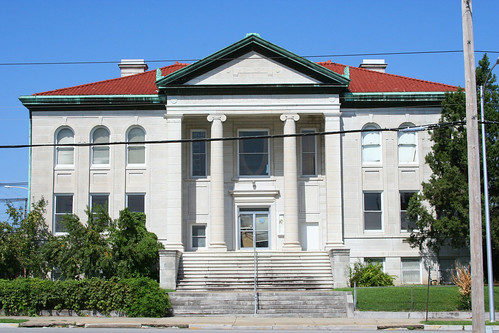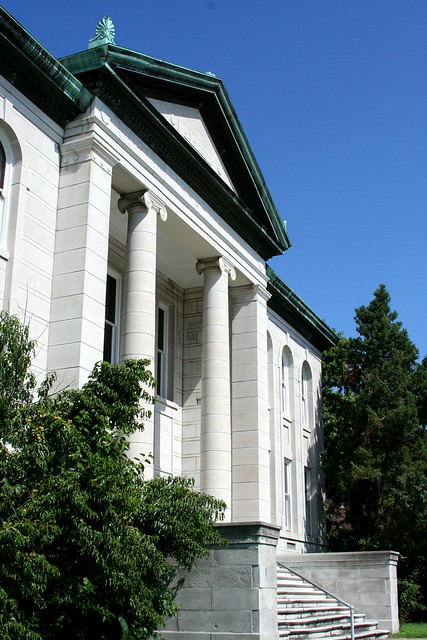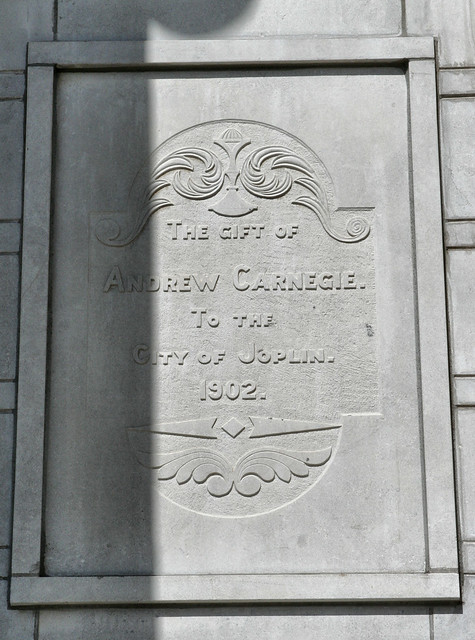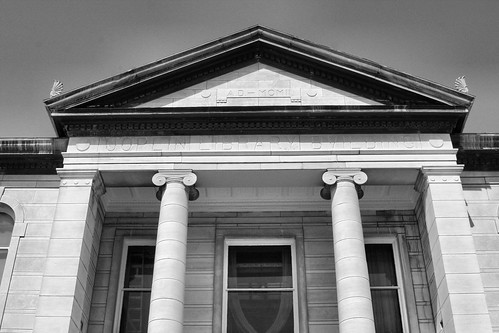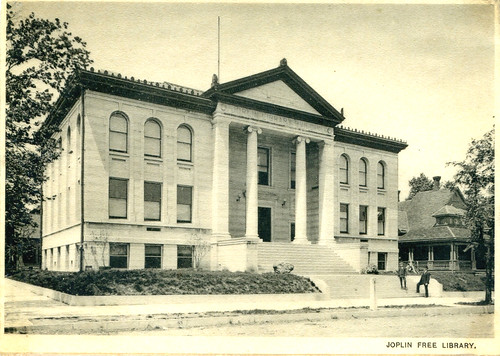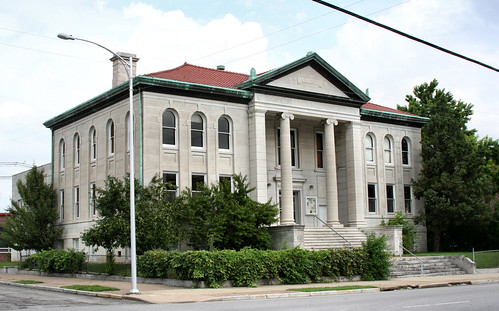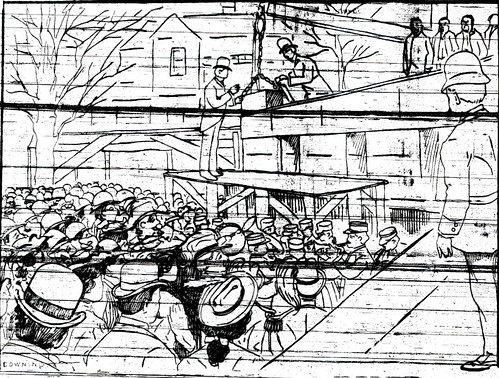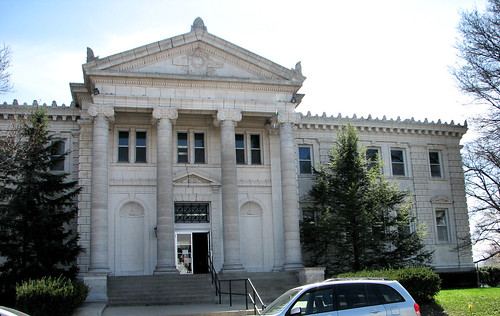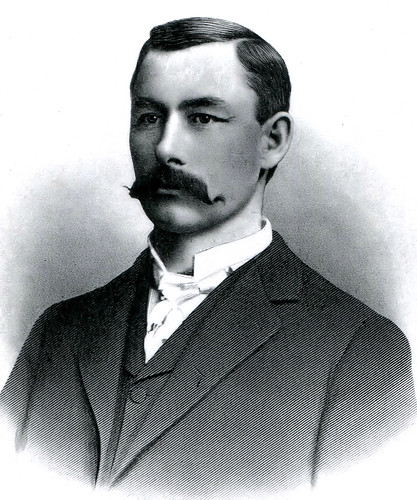Last summer, Historic Joplin wandered about downtown with a camera and one of the stops was the Joplin Carnegie Library, the former home of the Joplin Public Library. Below are a few of the photographs from that visit. Previously, we’ve brought you the history of the library building (here and here), as well a glance at how the library has changed or not changed over the century since its construction. Enjoy!
Renovated Union Depot Proposed Home For Museum
At last night’s City Council meeting, City Manager Mark Rohr proposed that the Union Depot be renovated to be used as a new home for the Joplin Museum Complex. As covered by the Joplin Globe, Rohr believes that existing sources of funding exist and as a result, no new taxes would be required for the project.
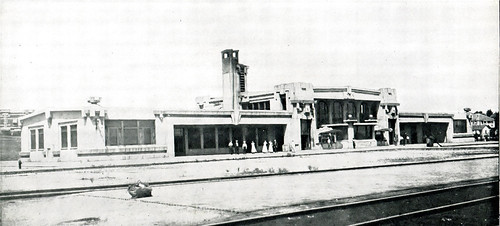
The Joplin Union Depot not long after it was opened. A great future home for the Joplin Museum Complex.
We, here at Historic Joplin, strongly support this proposal. We hope that it becomes reality and that someday in the near future, we can walk in and enjoy a beautifully restored depot. Even though the Carnegie Library appears not to have been part of the new plan, we hope it too has a bright future.
Joplin Carnegie Library – Then and Now
The Joplin Carnegie Library may come up in a city plan to be discussed tonight, July 6, 2010, by City Manager Mark Rohr, as part of the redevelopment plan for the city. As such, we figured to show a series of photographs (and one drawing) of the Joplin Carnegie Library.
First, we have the award winning sketch of the library by August Michaelis, a distinguished Joplin architect of the time.
Next we have a photograph not long after it was built:
Now we have the library as it appears today. It is privately owned, but in need of restoration. It is easily one of the most beautiful buildings in Joplin.
Source: Historic Joplin Collection
The Museum Issue May Rise Again
On Saturday, July 3, the Joplin Globe spoke with City Manager, Mark Rohr, about an announcement he will give on Tuesday, July 6. Rohr was responsible for the planning behind the revitalization of the Sunshine Lamp district in 2005. It was implied in the article that remaining elements of the 2005 plan may be addressed, those being the restoration and use of the neglected Union Depot, the currently privately owned Carnegie Library, and the Rains building. It was in that plan that the Museum Complex was to theoretically be moved to the depot.
Historic Joplin supported this solution to the museum problem back in April and certainly continue to support it. The depot is one of the city’s last remaining architectural beauties and there need not be any further Connor travesties by allowing it to fall to pieces or purposely tear it down.
For a two part history of Joplin’s Carnegie Library, click here and here.
The Joplin Carnegie Library and the Origins of Joplin Public Library: Part Two
Under a bright October afternoon sun, a crowd of ten thousand gathered to watch a parade snake its way from Fourth and Joplin streets to Main Street. It turned under the watchful gaze of the Keystone Hotel and then proceed south to Ninth, where it turned again to the right and came to a stop at Ninth and Wall. It was October 8th, and the people of Joplin had come to celebrate the laying of the cornerstone of the new Carnegie Library.
The parade had formed at 2:30 pm and consisted of a number of different groups. In the vanguard was Police Chief Jake Cofer with a platoon of police officers. Behind the police, the South Joplin band played and stomped in celebration, and were followed by 66 members of the Knights Templar from Joplin and the surrounding area. The contingent of Knights Templar was outnumbered by the 151 members of the Masonic Blue Lodge. Behind the Masons came 2,386 excited school children, headed by 29 high school students and teachers, walked four abreast down the city streets.
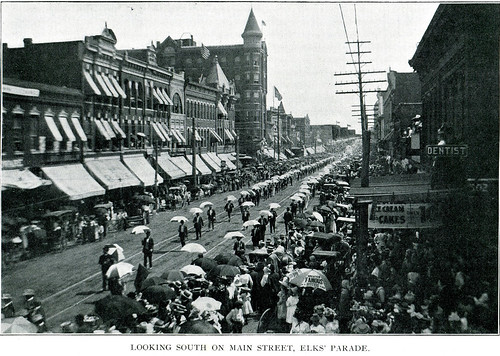
A different parade, but an example of a parade down Main Street and how the Elks might have marched that October afternoon.
Behind the flood of children came 24 grey headed members of the Grand Army of the Republic from Joplin’s O.P. Morton Post. As in 1865, the veterans marched proudly behind a cherished battle flag. Approximately 60 individuals of the Elks and Eagles followed the veterans and then bringing up the rear were thirty members of the Knights of Pythias commanded by Joplin attorney Joel T. Livingston.
Thousands surrounded the construction site of the library. The limestone walls soared over the crowd, such was the progress that had been made since Augustus C. Michaelis was selected as the architect in February. A platform rested against the side of the building next to where the cornerstone was to be laid. Children, anxious to see the ceremony, climbed the surrounding trees and hung perilously from branches.
A band took up position beside the platform while the mayor of Joplin, John C. Trigg, climbed onto the platform to address the crowd. His speech, the lengthiest of the day, began with the origin of the movement for the library. The mayor boasted that the tax revenue from property valued at $4,000,000 was more than sufficient to support the library, but also noted that it had not been enough for the construction of the building. For this, Mayor Trigg credited industrialist Andrew Carnegie who, “came to the rescue and dissipated all doubts and disquieting fears.” Trigg continued:
“No event in the history of the city of Joplin will perhaps stand out in bolder or more prominent relief in the future than the laying of the corner stone of the Carnegie public library building…It should be accentuated as a distinct epoch in the annals of the city, from which to date as from the dawn of the new century, an augmented zeal in the material, moral and intellectual improvement of our people of all classes and conditions…”
After the mayor established the effect of the library on the city, he then described the benefit of books, “The inestimable value of books is no longer a vexed or mooted question. The wise, the good and the great of all ages and nations, divines, poets, philosophers and statesmen, have contributed the most cogent and convincing testimony in support of the premise.” Trigg went on, reading excerpts from such authors as Joseph Addison, Richard DeBury, and Louisa May Alcott. Finally, and perhaps to the relief of some in the crowd, the mayor concluded his speech. This was followed by a brief rendition of the song, “Remember Now Thy Creator,” that setup the next speaker, Reverend Paul Brown. Brown was a substitute for Judge Picher, who had been unable to attend the ceremonies that day.
Reverend Brown reflected on the origin of free libraries and then spoke of libraries as essential to democracy:
“What is the end of democracy? I answer the end of democracy is a natural aristocracy. There is an aristocracy of nature which no contract or statute can ever abolish….Here in the district, our chief industry, mining, weeds out weaklings and cowards, and creates a natural aristocracy of physical courage and vision in the depths of the earth. Now what does democracy guard against? Not natural aristocracy, but artificial, the aristocracy of mere birth or place or force or accident. Democracy means that equality of opportunity which will give the natural aristocracy a chance.”
It was books, Brown argued, that provided the opportunity for men to overcome the privileged aristocracy who were born to fame, title, or fortune. Brown, after noting famous authors of history, praised the city’s superintendent, J.D. Elliff, whom Brown stated, had played the crucial role in seeing the library created. Brown soon concluded his remarks, followed by a song from the band, and again, when the time finally came for the actual laying of the cornerstone.
This august moment was overseen by the Most Worshipful Grand Master of the Masons, John C. Yocum. The Grand Master announced the placement of the cornerstone, as it was guided by a small crane and lowered carefully into place. An invocation was given by the Mason’s Grand Chaplain, who was accompanied by the Masonic ceremonies of deposit and consecration. One last speaker arose, Dr. W.P. Kuhn, a senior grand warden of the Masons from Kansas City. Dr. Kuhn opted to win the crowd through praise of the children present, as well a quick joke about Methodist and Presbyterian preachers:
“ The Methodist preacher never prepared a sermon or at any rate never had any reference notes, but his services were largely attended, while the Presbyterian divine labored conscientiously over his discourses, wrote them painstakingly out and read them with painstaking fidelity. But, his flock was few, and in a spirit of discouragement he came to the Methodist preacher and asked him why it was that the people crowded to hear him who never prepared a sermon while his own church was all but empty. And the Methodist replied, “My good friend, you write out your sermons and the devil is right there behind you. He knows every word that you’re going to say and he is able to circumvent every effort you make, no matter how praiseworthy. Now I don’t know what I’m going to say and I know the devil don’t know what I’m going to say either, and that’s the difference between us.”
Dr. Kuhn concluded by stressing the importance of free libraries, as they were part of the “three planks that the structure of every American community is founded.” The other two planks were free thought and free speech. Immediately after the crowd sang, “America,” and the cornerstone laying ceremony ended with a benediction offered by the Rev. Charles A. Wood.
With the cornerstone laid, construction on the library resumed. The building incomplete, the actual Joplin library, which was already in existence was housed at the Joplin high school and overseen by Lucile Baker, the first librarian. Ms. Baker was a writer for the Joplin News-Herald and used the byline of “Becky Sharp” in a nod to Missouri’s own Mark Twain.
The library was finally completed a year later. The city received its first check from Andrew Carnegie at a sum of $5,000. Twelve years later, the city sought and received another $20,000 from the generous benefactor for an addition to the west side of the library. In charge of the library, now at home in its new building, was Mary B. Swanwick, who was joined by assistant librarians Blanche Trigg, Mary Scott, and Hattie Ruddy Rice.
As of 1911, the library had 15,737 books as well as 2,643 magazines and periodicals. Over the year, over ten thousand people used the library, around 1/4th of the city’s population, and almost 65,000 books were circulated. Active card holders numbered almost 7,000. Ten years later, the head librarian, Swanwick, passed away and was eventually replaced by Blanche Trigg, daughter of Joplin Mayor John Trigg. She oversaw the institution until 1949. It was under the oversight of Trigg’s successor, Margaret Hager, who helped lead the movement in the 1970s to purchase the Connor Hotel and the rest of the 300 Block as the site of a new library building. That building, the present home of the Joplin Public Library, opened in April, 1981.
Sources: Joplin News Herald, Joplin Globe, “A History of Jasper County, Missouri and its People,” by Joel Livingston, and Missouri Digital History.
The Joplin Carnegie Library and the Origins of Joplin Public Library: Part One
One of the major institutions of modern day downtown Joplin is the Joplin Public Library located in the 300 block between the Third and Fourth streets. The prior occupant of this site was the Connor Hotel. Plans to purchase the block, demolish the Connor, and to erect a new library building began in the 1970’s. The Connor collapsed a day before its scheduled demolition in 1978, and all but a few minuscule pieces of the grand hotel remained on opening day of the new library building in April, 1981. Up until that spring day twenty-nine years ago, the Joplin Public Library had been housed in a Romanesque building, a columned temple of knowledge, a few blocks to the southwest. The origin of it and Joplin’s library system began more than a century ago.
Undoubtedly, the idea to establish a city library came into being not long after Joplin began to establish its schools and a professional class. The dust of the lead and zinc mines was shaken off by a city that pulsed with a passionate desire for progress. In April 1893, a gathering was held at the Young Men’s Christian Association building. It was the first formal meeting of the Joplin Public Library Association. Hamilton S. Wilks was elected president, along with Christopher Guengerich as treasurer, the Reverend E.E. Wilkey as secretary, and C.W. Squire as vice-president. In addition, an executive committee was established with the following women: Mrs. W.H. Picher, Mrs. Clark Craycroft, Ms. Henry Weymen, Lola Spear and Mrs. W.C. Weatherill.
The initial funds to assist in the creation of a library came from a charity event hosted by the Century Club. The club, established only three years previously, was a women’s literary society. Its members embarked on a campaign to create a city library through education and outreach. While a public reading room had been the original idea for the city’s library, it became obvious that an independent library building was needed. The Century Club, and other Joplin literary clubs, claimed victory in the city election of 1901. The months before the vote had been spent campaigning for an annual tax of ten cents for every one hundred dollars appraised for the care and maintenance of a library building. The measure was overwhelmingly approved.
This tax was connected to a requirement to form a non-partisan board to oversee the construction and operation of the library. Ten individuals were appointed to the board: William N. Carter, H. H. Gregg, J. D. Elliff, Henry Kost, E. L. Anderson, Reverend Paul Brown, O. H. Picher, Mrs. Ada Goss Briggs, Mrs. Emma Lichliter and Mrs. Hattie Ruddy Rice. Elliff, the superintendent of Joplin’s public schools, was elected president by the board, while the position of board secretary was given to Rice. Shortly after, the board created a committee tasked with overseeing the building and grounds of the future library.
Around May, 1901, that committee explored the possibility of contacting the capitalist Andrew Carnegie. For just under twenty years, the Scotsman offered funds to cities for the construction of libraries. Generally, these donations came upon the promise that the cities guarantee a specific amount of upkeep and continue funding of the institutions. Not long after the president of the board, J.D. Eliff sent off a letter to Carnegie, a reply was received from James Bertram, Carnegie’s personal secretary. Addressed from Skibo Castle, Ardgar, Bertram wrote:
Dear Sir – Responding to your letter of May 6th–If the city of Joplin will furnish a suitable site and pledge Itself to maintain the library at a cost of not less than $4,000 a year. Mr. Carnegie will be glad to provide $40,000 for a suitable building.
Very Respectfully.
James Bertram. Private Sec’y.
The promised sum of $40,000 delighted the board. The question then turned to what the library should look like and where that building should be located.
The discussion of location and design carried on through the months of 1901 and into the first quarter of 1902. It was not until October, 1901, that the board finally came to a decision on the placement of the new library. Proposed locations included the intersection of Eighth and Pearl streets, Cox Park (advocated by the people of South Joplin), and the intersection of Joplin and Ninth streets. The two most popular sites, however, were the intersections of Fourth and Pearl and Ninth and Wall streets. The former were owned by a man named Renfrow and the latter by Christopher Guengerich. According to coverage by the Globe, the board’s primary concern was a location which benefited the entire population of the city.
The board came to a decision on the location on October 21, 1901, when by a vote of 5 to 4, the Ninth and Wall location barely beat out the Fourth and Pearl site. Prior to the vote, attorney and amateur historian Joel T. Livingston offered a presentation, complete with a special map of the city that how the population of Joplin was concentrated. Incidentally, while Livingston claimed to favor no specific site, his analysis of the city’s population placed the epicenter around Eighth and Wall streets. If this swayed the votes toward the Ninth and Wall location, the site was further helped by the testimony of J.W. Freeman, who claimed the location would satisfy the people of South Joplin. It was future Missouri State Senator Hugh McIndoe, as well as Freeman Foundry owner J.W. Freeman, Oscar and C.M. DeGraff, as well as Clay Gregory, who introduced the successful proposition. Thus, the chosen site had strong and influential supporters. As to what type of building would be built at the corner of Ninth and Wall, the discussion continued into the next year.
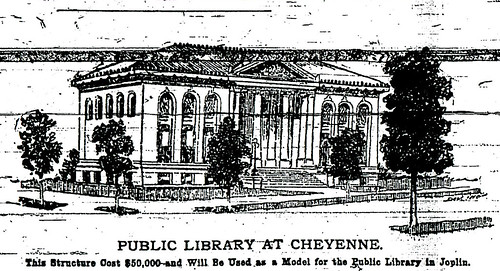
The Cheyenne Carengie Library design that William Carter favored and became the basis for Joplin's library.
The committee in charge of selecting the design of the library took their task seriously. Initially, a question of whether the city would offer the local Joplin architects was debated. One of the chief proponents against hiring local talent was William Carter, who when asked about the successful architect August Michaelis, sneered, “He learned his business in Joplin.” Carter went on to point out that Joplin had no libraries or similar buildings, and as such, Michaelis had no experience in designing a library. Another supporter of seeking a non-local architect was Ada Briggs, who read a letter written by the president of the Sedalia Library board. Prior to this meeting, members of Joplin’s committee had visited the city to their north to view their Carnegie library. In the letter, the president warned against allowing local architects to use Joplin’s library as an opportunity to learn how to design such a building.
Plans based on the designs of numerous libraries were pushed in an attempt to avoid hiring area architects. One such architectural rendering was the Sedalia, Missouri, public library, which was quickly dismissed for a variety of reasons. It was too big for the lot picked out previously; it failed to include a basement or a separate women’s assembly room; and it cost an additional $10,000 more than Joplin had budgeted. Nevertheless, Ada Briggs described the building as, “beautiful simplicity.”
In lieu of the Sedalia design, Carter suggested the design of the Carnegie library in Cheyenne, Wyoming. Apparently, the news of Joplin’s library design search had spread, as the architect of the Cheyenne library visited Carter the week before to sell him on the design of that building. Carter went so far as to suggest a trip to Cheyenne, similar to that which had gone to Sedalia, but the expense and length of the trip resulted in no support for such an adventure.
In the end, the committee opted to allow local architects to submit plans, based on the fact that a majority of the committee believed that they had already proven themselves with many beautiful buildings about the city. It was even remarked that this was a difference between Joplin and Sedalia. One city had remarkable architecture and the other did not. The committee then reasoned that the advice of the Sedalia library board’s president to seek elsewhere for an architect could be ignored simply because Sedalia did not have any local architects of considerable skill. The plans of three firms were accepted to be voted upon. The three were Garstang & Rea, I.A. Hunter, and August C. Michaelis.
At 2’o clock in the afternoon on February 3, 1902, the committee selected the plan presented by Michaelis. By specification, the design was similar to that of the Cheyenne Library, but not an identical copy. This requirement was probably added to soothe those members, like Carter, who did not want to trust the design to local architects. It featured three floors, a basement, first floor, and second. Located in the basement was to be the men’s reading room, advertised as a place men could visit in or out of work clothes, as well go so far as to enjoy a smoke while perusing book or newspaper. Filling out the basement was a coal room, toilets, and the boiler. Upon rising to the next floor, the visitor found a main hallway of 33 square foot of marble flooring.
On one side of the floor the general reading room was placed connected by doorway to a reference room. Opposite the general reading room was a reading room expressly for children. In addition to a reference room, a room was set aside for librarians and contained a fire proof vault. At the rear of the floor was located a circular stacks, which at the time was supposed to be filled with steel fire proof shelving. The shelves were to be arranged in a circular fashion with the librarian seated in the center and thus with a 360 degree view of the room. The stacks were expected to hold approximately 30,000 books.
Also located on the first floor was a wide double staircase that rose to the second floor. On this uppermost floor was located a room for the women’s club with attached rooms and bathroom. A statuary hall mirrored the hallway below and at the time was thought to be an ideal display area for mineral examples. Separate rooms were set aside for art and for trustees, as well a private reading room. The rooftop was shingled in zinc, though a brief controversy arose when someone claimed architect Michaelis had said otherwise. Michaelis confirmed that the library would indeed have zinc roof tiles. The library was heated indirectly with steam. The library was filled with oak furniture and countertops.
A plan in hand, all that remained was for construction to begin. Part Two will continue the history of the Joplin Carnegie library.
Sources: Joplin News Herald, Joplin Globe, “A History of Jasper County, Missouri and its People,” by Joel Livingston, and Missouri Digital History.
